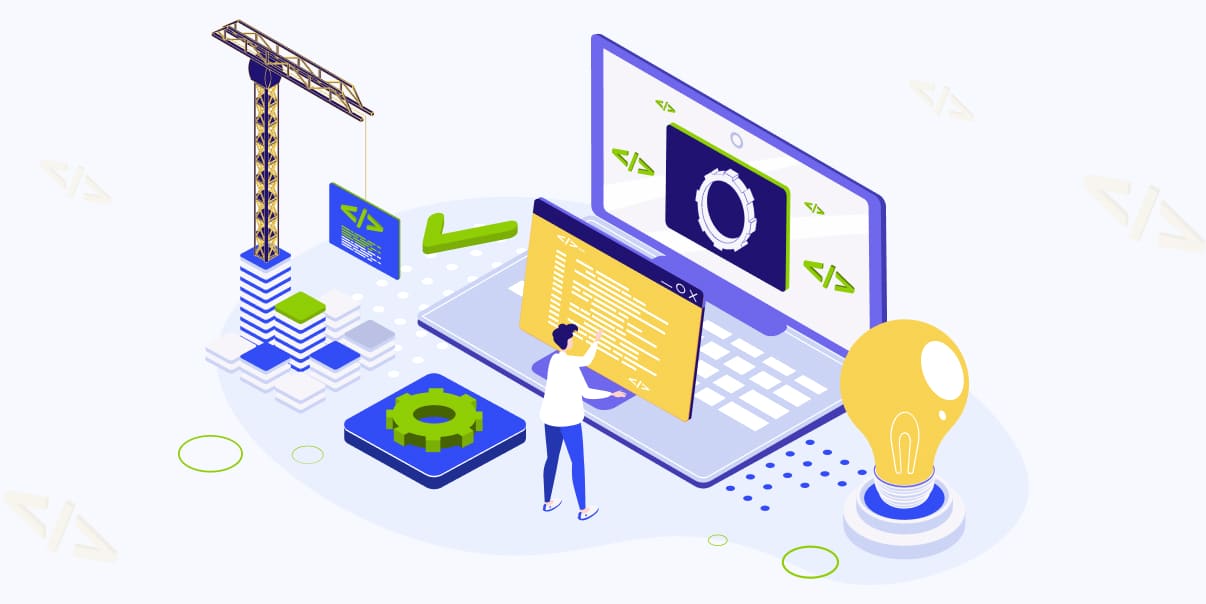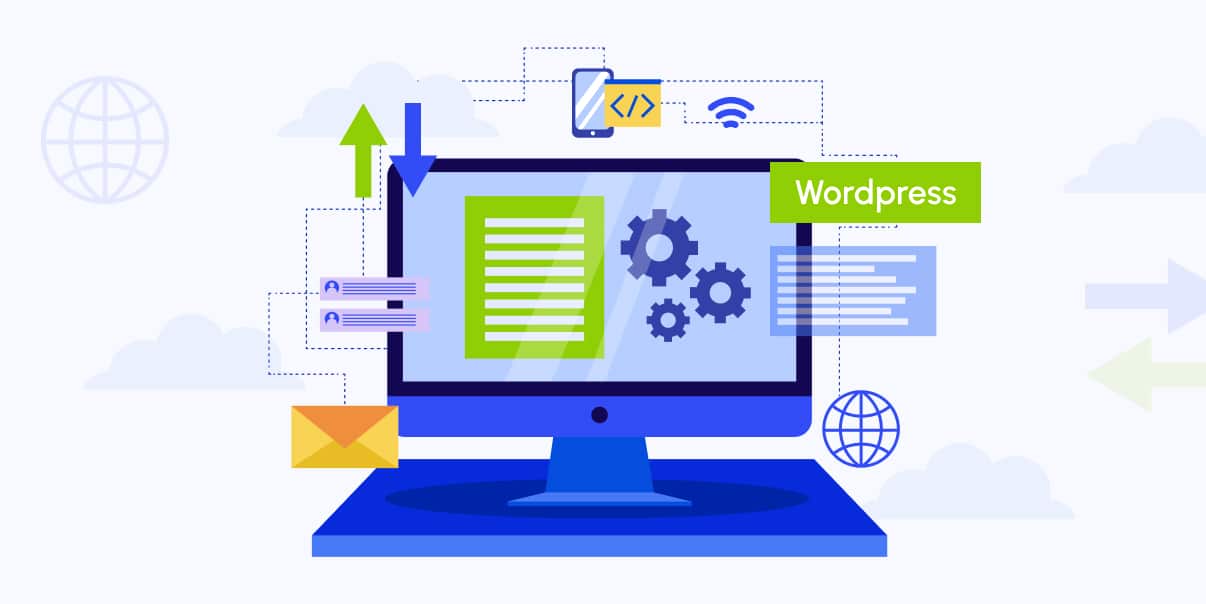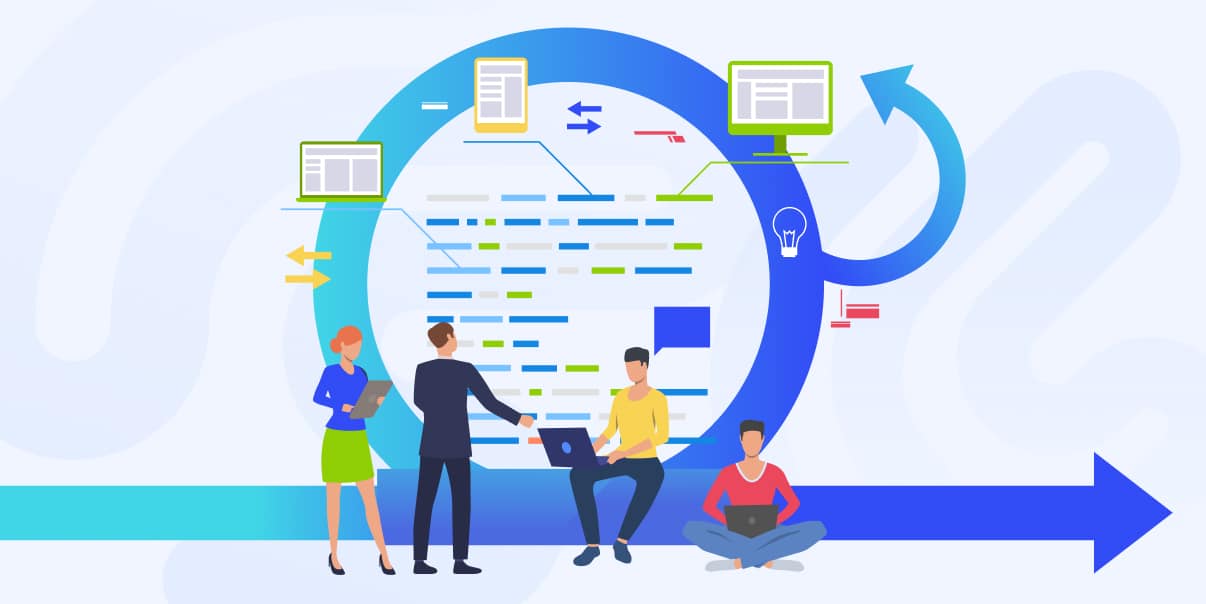Agile Product Development: A Comprehensive Guide

Agile product development is one of the best approaches to software development services. Teams turn to agile because it’s flexible and allows people to work together. This approach makes it possible to develop products faster while delivering high-quality results.
Let’s get started with a clear definition of agile product development.
What Is Agile Software Development?
Agile product development refers to an approach to software and product development. It emphasizes working together, being flexible, and delivering valuable products quickly. This approach involves being able to change the product roadmap promptly. Agile developers adjust in response to customer feedback or market changes.
The Agile Product Development Process
The agile software development cycle has four stages. These stages are repeated over and over again throughout the entire development lifecycle. The development team usually sets up the repetition into sprints lasting between one week to a month. In each step, the team works together to build a quality product. In each step, the team works together to build a quality product.
In the planning phase, a product manager leads the team to define the project’s scope, assign tasks, and develop a timeline. Designers create wireframes and user interfaces that show how the product should look and function.
In the design phase, developers use technologies such as HTML and CSS to create the product. They work with designers to ensure the product looks and functions as intended.
In the coding phase, developers write code to bring the product to life. They create databases, set up web servers, and write algorithms for processing data. The development team works together to ensure everything works before moving on to testing.
Testing is the final phase. This phase ensures that the product meets user requirements and performs as expected. Once testing is complete, the product is ready for launch.
By following the agile software development process, teams can create high-quality products. This approach increases customer satisfaction and improves team morale.
The Agile Methodology
The agile methodology is a way of making software products. It involves testing things often and getting feedback from customers. The goal is to create high-quality products quickly and meet customer needs. Moreover, agile development helps you save money and make better products faster.
What Is Scrum Methodology in Agile Product Development?
Scrum is an agile approach focusing on collaboration, flexibility, and quick delivery cycles. It involves breaking down a project into smaller tasks and setting up short sprints to complete them.
At the end of each sprint, teams review their progress and plan for the next one. Progress review allows teams to adapt quickly to customer feedback or market changes. As a result, agile teams deliver quality products faster.
Scrum methodology helps businesses save money by reducing costs and improving efficiency. Finally, it helps improve team morale by working together towards common goals.
The core of scrum methodology is the use of small, self-organizing teams. Each team tackles one part of the product simultaneously. This way, the team can quickly adapt to changes and deliver high-quality products faster.
What Is Kanban and Its Use in Agile Product Development?
Kanban is a system of visual management. It helps teams track the progress and outcomes of their product development. Each task is represented on a kanban board.
A kanban board is like a big picture showing the team’s tasks. Each task is like a puzzle piece. Every piece helps teams keep track of their progress and see what they have accomplished.
Since each member can see each others’ tasks, collaborating is easier. The system also helps teams identify bottlenecks and prioritize tasks. Kanban methodology allows teams to be more productive and deliver high-quality products faster.
Comparison of Scrum and Kanban in Agile Product Development
Kanban and scrum are two popular approaches to agile product development. Both of these methods have proven to be effective in helping teams deliver high-quality products faster. But there are some critical differences between the two that you must understand.
Scrum is a process-oriented approach. It involves breaking down a project into smaller tasks. On the other hand, kanban is a visual management system that helps teams track progress and outcomes. Scrum delivers results quickly by setting short sprints. Kanban emphasizes collaboration and flexibility to adjust to customer feedback or market changes.
In conclusion, these agile methods are helpful and can help teams deliver high-quality products faster. Understanding their differences is essential to choose the right approach for a project.
The Principles of Agile Product Development
Agile product development has a few fundamental principles that guide the process. Following agile principles helps teams to work together more effectively. Here they are:
Customer Collaboration
Customer collaboration is essential for agile product development. You should involve the customer throughout the product development process. Get their input from idea generation to design and testing. Doing so ensures that the product meets their needs. It also helps teams better understand what features are most important.
Early Delivery
Early delivery means releasing products or features as soon as they are ready. The customers do not need to wait for the entire product to be finished. This principle allows customers to start using the product sooner. It also helps teams build trust and credibility with their customers.
Continuous Improvement
Continuous improvement means making small, incremental updates to the product to improve it. It can help teams reduce costs and increase customer satisfaction with the product.
Continuous Delivery
Continuous delivery means delivering the product in an iterative process. This way, teams can continue to improve the product as they get customer feedback throughout the development cycle.
Cross-functional teams
Cross-functional teams involve members from different disciplines. They work together to ensure that all aspects of the product are well-integrated. With cross-functional teams, your agile product development process will be more efficient.
Empowered Teams
This principle means giving the team the authority and resources they need. Doing so helps them make decisions quickly and meet customer needs. Empowered software development teams create a culture of ownership and responsibility. As a result, teams deliver high-quality products faster.
Individuals & Interactions
This principle means that the focus should be on individuals and how they work together. It pushes processes and tools to the back burner. This way, teams can make decisions quickly and work together to create great products.
Scalable Processes
This principle means having processes that can scale up or down quickly as needed. Scalable processes help teams respond to customer feedback or changes in the market.
Adaptive Planning
Adaptive means being able to adjust plans quickly. It helps teams stay organized and deliver results faster.
Deliver Working Software
In this principle, teams release finished products or features before the entire product is complete. It helps teams deliver value to customers faster and improve customer satisfaction.
Advantages of Agile Product Development
Product development with an agile framework can provide numerous benefits. Here are some of them.
- Faster Time to Market
An agile product development process can drastically reduce the time it takes to bring a software program to customers. Agile is an efficient delivery method. It involves working in smaller chunks and allowing room for testing before releasing the final version.
- Better Quality
By following an agile process, teams can produce higher-quality products. The agile methodology emphasizes testing and client feedback. Plus, the development team can perform testing often to ensure each feature works correctly before launch.
- Improved Team Morale
Agile software development encourages teams to collaborate. When they are comfortable with each other, they stay organized and motivated. This model promotes collaboration and leads to better team morale.
- Increased Customer Satisfaction
By involving customers during development, teams can deliver products that meet their needs. It increases customer satisfaction by ensuring they get the features they need.
- Increased Flexibility and Adaptability
Agile methodology is flexible. It allows product teams to adapt quickly. Adaptability helps them respond quickly to client feedback or market changes.
- Improved Communication
By using an agile framework, teams can communicate better and understand each other better. It helps teams work together more effectively to create great products.
- Enhanced Customer Satisfaction
The agile methodology delivers value to the customer fast. It makes sure the customer gets the features they expect on time. Plus, it ensures customers get what they need quickly and stay satisfied.
- Increased Productivity and Efficiency
The agile model helps teams stay organized, increasing productivity and efficiency. It ensures tasks are completed on time. Plus, it encourages team members to take ownership of their work. Efficiency leads to fewer delays, missed deadlines, and budget overruns.
- Easier Documentation
Agile product development makes it easier to document the entire process. Teams can create detailed documentation that includes user stories, tasks, and timelines. Documentation makes the development process clearer for everyone involved.
Challenges To Overcome When Implementing Agile Product Development
There are a few challenges associated with the agile methodology. Here are some that you may face:
- Lack of Knowledge and Experience
Agile is a relatively new and complex approach to product development. Teams may need more knowledge and experience to use the framework effectively. This problem can lead to delays in delivery or low-quality products.
- Resistance to Change Within an Organization
Organizations and teams may refrain from using the agile method because they are used to traditional approaches. It may take time for them to get used to the new strategy and learn how it works. Resistance to change can lead to conflicts between team members or slow down the process.
- No Clear Goals or Objectives
Having clear goals and objectives helps teams stay focused. It ensures teams focus on important tasks and deliver the desired results.
- Difficulty in Measuring Progress and Success
The agile methodology relies on feedback because it is an iterative process. It can be challenging to measure progress and success when using this approach. Software development teams may need help deciding which features they should implement. They may also need help predicting how long the development process should take.
- Lack of Clear Project Ownership and Accountability
When working in an agile environment, teams may need a project manager who will be accountable for the results. It can lead to delays and low-quality products because no one takes ownership and responsibility for the project.
- Limited Ability to Handle Large, Complex Projects
The agile methodology works best for small, straightforward projects. It is not ideal for large, complex projects. Big projects may require more resources as the process is iterative.
There may be several challenges, but don’t lose heart! With proper planning and implementation, agile teams can overcome these challenges.
Best Practices of Agile Teams for Implementing Agile Product Development
Here are the best practices you must keep in mind if you want to adopt the agile methodology into your business process:
Start Small
It’s essential to start with smaller, achievable tasks and slowly ramp up the project’s complexity as you go along. Doing so will help keep your team focused on their goals and allow them to stay productive.
Sprint Planning
Before each sprint, you should create a plan outlining the tasks and goals for your team. Sprint planning will help keep your team on track and ensure they can stay productive throughout the process.
Create a Dedicated Team
A dedicated agile development team will help you stay focused on the project and ensure everyone works together. You should give this team clear instructions and guidelines, so they know what you expect of them.
Define Product Vision and Goals
Defining a product vision and goals is essential before you begin the project. A well-defined vision will keep the team focused on their tasks. Plus, it can provide a clear direction for the development process.
Develop Clear Processes and Guidelines
Transparent processes and guidelines ensure everyone is on the same page with the development process. Clear guidelines will make it easier for everyone to stay organized and productive during the project.
Perform Regular Testing
Product teams should perform testing regularly throughout the development process. Regular testing helps identify potential issues or bugs before they become a problem. Also, it ensures that the product meets the customer’s expectations.
Provide Regular Feedback
Giving regular feedback to the agile development team can help keep them motivated and productive. It also provides an opportunity to address issues or problems quickly. This way, they don’t become more significant issues down the road.
Use Short Iterations
Using shorter iterations ensures that the team is progressing and staying on track with its goals. Doing so will also make it easier to adjust the project if any changes are needed along the way.
Prioritize Customer Needs
It’s essential to prioritize customer needs when developing an agile product. It will help ensure that the product meets the customer’s expectations and can also help guide the development process.
Use the Right Tools and Technologies
Using the right tools and technologies can help optimize the development process. It will make it easier for agile teams to collaborate and stay on track with their tasks. It’s important to choose tools that are easy to use, efficient, and cost-effective.
Encourage Continuous Learning and Improvement
Continuous learning ensures that every member of the team is up-to-date with new technologies. It can also help identify areas that need to be improved.
Foster a Collaborative and Supportive Environment
A collaborative team is beneficial for a successful product development process. Plus, a supportive agile environment ensures that everyone on the team achieves goals faster.
Encourage Transparency in Communication
Transparency is essential for any successful agile development process. It will help ensure that everyone on the product team is up-to-date with the project. Plus, it also helps resolve any potential issues quickly.
Regularly Review and Adapt the Product Backlog
Product managers should regularly review and adapt the product backlog. Doing so will help ensure that the product team stays on track with its goals. Also, it can help identify any potential issues or changes before they become a problem.
Implement Agile Metrics
Using agile metrics can help you measure the progress of your project and ensure that it stays on track. This practice makes it easier to identify areas of improvement. This way, you can adjust the agile product development process as needed.
Review the Agile Framework Regularly
Regularly reviewing the agile framework is essential to ensure it works effectively. This practice ensures that the team stays on track with its goals. It also allows for changes and improvements as needed.
Retrospectives & Reflection
Periodic retrospectives and reflections help product managers to assess the team’s progress. It helps identify any issues or problems and develop solutions you need to implement quickly. This practice helps to ensure the continual growth of the project.
Following these best practices will give you everything you need to create an agile product!
Conclusion
Surely, software development companies will continue to use the agile methodology in the coming years. It is a practical approach to developing products quickly and efficiently. Agile product management helps teams stay organized and encourages collaboration. Plus, it allows teams to respond promptly to feedback or changes in the market. Your agile product will be successful by following the best practices outlined in this article.
At BIT Studios, we believe in the power of agile product development and strive to use it with all our projects. Our team can help you develop an effective agile strategy and ensure your project succeeds. Contact us today to learn more!
Best of luck with your next agile project!
We’re BIT Studios!
At BIT Studios we specialize in designing, building, shipping, and scaling beautiful, usable products with blazing-fast efficiency



